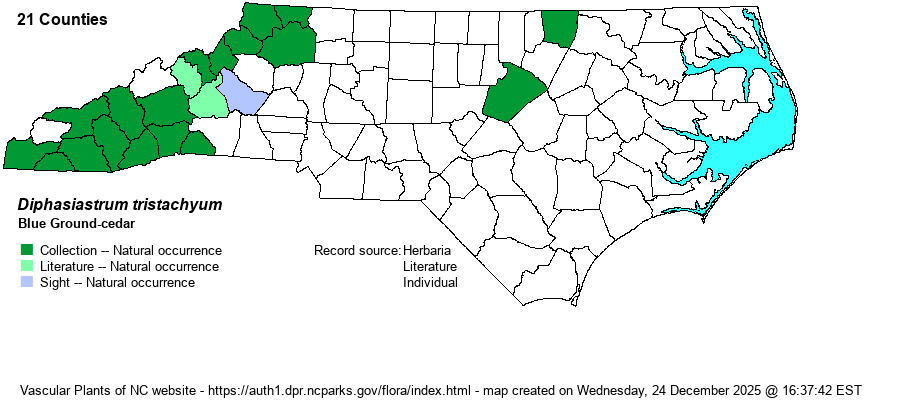| Author | (Pursh) Holub | |
| Distribution | Essentially throughout the Mountains. A few disjunct records in the eastern Piedmont (Wake and Warren counties), though there are records in southeastern VA. The Wake specimen came from banks of the Neuse River at rte. 59 bridge in 1950. Two specimens from Orange County (at CATU) were collected in 1978 but lack images on SERNEC; as they are student collections, they need to be verified.
This is a Northern species, ranging across eastern Canada south to VA and WI, and then sparingly southward to northern GA and northern AL.
| |
| Abundance | Fairly common to frequent in the Mountains, at least locally. Very rare if not now historical in the northeastern Piedmont. | |
| Habitat | This species grows in dry settings at high to middle elevations, usually where rocky. It is found at grassy balds, forest openings, glades, and in rocky forests. | |
| Phenology | Fruits from July to September. | |
| Identification | This is an evergreen species with glaucous, blue-green foliage. The long stem runs along the ground for 2-3 feet, sending up scattered and rather erect branches to about 8-10 inches tall. This species has each branch somewhat dichotomously branched, with somewhat ascending (and very narrow) branchlets, giving a different visual aspect from the more widely branched and palmate-looking segments found in the greener-colored D. digitatum. The strobili are on tall stalks several inches above the foliage, each about 1-2 inches tall. Most biologists should not have any difficulty separating this species from the quite common D. digitatum. | |
| Taxonomic Comments | This species was universally named in older references as Lycopodium tristachyum; only it and D. digitatum (of the NC species) have been pulled out of the formerly large group of Lycopodium species.
| |
| Other Common Name(s) | Blue Clubmoss, Deeproot Clubmoss | |
| State Rank | S3 | |
| Global Rank | G5 | |
| State Status | | |
| US Status | | |
| USACE-agcp | | |
| USACE-emp | | |

